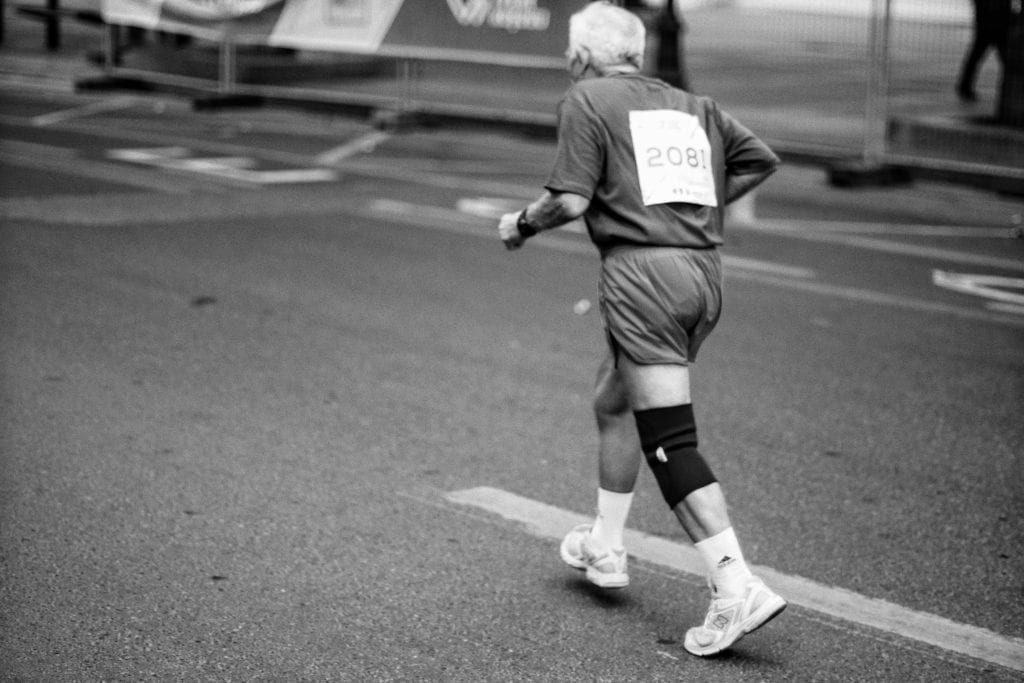DEUTLICH ERHÖHTE LEBENSERWARTUNG BEI AUSDAUERSPORTLERN
Ich bin im SPORTambulatorium immer wieder mit der Feststellung konfrontiert, dass AusdauersportlerInnen die Jahre und Jahrzehnte auf hohem Niveau trainieren, doch eine signifikant höhere Mortalitätsrate haben müssen – höher im Vergleich (auch zur unsportlichen) Restbevölkerung, da es durch die hoch-intensiven Belastungen häufig zu Herzrhythmusstörungen komme.
Wenn man sich die aktuelle Studienlage ansieht, stimmt das nicht – im Gegenteil – auch Ausdauersport auf hohem und höchsten Level verbessert die Lebenserwartung signifikant.
Natürlich ist das Herz bei kompetitiven AusdauersportlerInnen einer hohen Belastung ausgesetzt, die allerdings bei einem Großteil der AthletInnen zu einer signifikant verbesserten Lebenserwartung, Reduktion der Gefahr an Krebs zu erkranken und einer deutlich längeren Unabhängigkeit im Alter führt.
Genial finde ich eine (zwar schon ältere, aber extrem große) Studie aus Schweden mit 73.000 hoch kompetitiven LangläuferInnen, die eine Reduktion der Mortalitätsrate von 57% im Vergleich zur Restbevölkerung zeigte.
Den sportlichen Zielen fürs neue Jahr steht also nichts im Wege!
Wir wünschen allen viel Erfolg beim Erreichen ihrer neuen Bestzeiten und neuen sportlichen Herausforderungen!

MORTALITY AMONGST PARTICIPANTS IN VASALOPPET: A CLASSICAL LONG-DISTANCE SKI RACE IN SWEDEN.
Farahmand BY1, Ahlbom A, Ekblom O, Ekblom B, Hållmarker U, Aronson D, Brobert GP. J Intern Med. 2003 Mar;253(3):276-83.
RESULTS
Overall, 410 deaths occurred, compared with 850.6 expected (Erg: compared to normal population), yielding an SMR of 0.48 [95% confidence interval (CI) 0.44-0.53].
A DECREASED MORTALITY WAS OBSERVED IN ALL MAJOR DIAGNOSTIC GROUPS, namely cancers (SMR = 0.61; 95% CI 0.52-0.71), diseases of the circulatory system (SMR = 0.43; 95% CI 0.35-0.51), and injuries and poisoning (SMR = 0.73; 95% CI 0.60-0.89). For lung cancer the SMR was 0.22, but even after exclusion of lung cancer the all-cancer mortality was low (SMR = 0.72; 95% CI 0.59-0.86).
THE ENDURANCE ATHLETES HEART: ACUTE STRESS AND CHRONIC ADAPTATION
Keith George,1 Greg P Whyte,1 Danny J Green,1,2 David Oxborough,3 Rob E Shave,4 David Gaze,5 John Somauroo1,6
Br J Sports Med. 2012 Nov;46 Suppl 1:i29-36.
CONCLUSIONS
The heart of the endurance athlete is placed under great stress during training and competition. Cardiac adaptation to exercise training encompasses morphological, functional and electrical changes that are referred to as the ‘athletic or athletes’ heart’. For the most part, the endurance athletic heart is easily differentiated from pathologies that may present with similar phenotypical characteristics. For those athletes that do present in the diagnostically challenging ‘grey zone’, on-going study will likely further refine physiologically normative data.
Acute (ultra) endurance exercise bouts represent a significant stress to the heart and there is now substantive evidence of ‘cardiac fatigue’ and/or biomarker release associated with prolonged activity. It is, however, entirely likely that for the vast majority of endurance athletes, the stress of acute exercise will lead to healthy, physiological adaptation in the heart. For a very small minority, though, there is emerging evidence that endurance exercise may be part of a patho-physiological cascade that clinicians must be aware of and respond appropriately too.
ALL-CAUSE AND DISEASE-SPECIFIC MORTALITY AMONG MALE, FORMER ELITE ATHLETES: AN AVERAGE 50-YEAR FOLLOW-UP.
Kettunen JA1, Kujala UM2, Kaprio J3, Bäckmand H4, Peltonen M5, Eriksson JG6, Sarna S7. Br J Sports Med. 2015 Jul;49(13):893-7
CONCLUSIONS
Elite athletes have 5-6 years additional life expectancy when compared to men who were healthy as young adults. Lower mortality for cardiovascular disease was in part due to lower rates of smoking, as tobacco-related cancer mortality was especially low.
REDUCED MORTALITY IN FORMER ELITE ENDURANCE ATHLETES.
Ruiz JR1, Fiuza-Luces C, Garatachea N, Lucia A. Int J Sports Physiol Perform. 2014 Nov;9(6):1046-9.
ABSTRACT
For centuries, the general consensus has been that vigorous, competitive exercise was harmful and shortened life expectancy. Recent data from prospective cohort studies conducted on marathon runners, professional cyclists, and Olympic athletes indicate, however, that regular intense endurance-exercise training has protective benefits against cardiovascular disease and premature death. There are still important questions to be answered, such as what is the optimal dose, in terms of both duration and intensity of training or competition, beyond which the health benefits of regular exercise stabilize or might even potentially disappear.
COMPETITIVE SPORTS AND THE HEART: BENEFIT OR RISK?
Scharhag J1, Löllgen H, Kindermann W. Dtsch Arztebl International. 2013 Jan;110(1-2):14-23;
PEARLS
Athlete’s heart is rarer than generally thought and is not a prerequisite for a beneficial effect of training on health. At least five hours of endurance training per week, and more in many cases, are necessary for the volume load to result in dimensional changes (e19). The amount is highly variable: Running 60–70 km per week leads to the development of athlete’s heart in some persons, while others do not develop it even if they run 100 km per week. Athlete’s heart appears most prominent in long-distance runners, road bicycle racers, cross-country skiers, and triathletes. Athlete’s heart may also develop in older endurance athletes. On the other hand, strength and speed athletes, such as weightlifters, gymnasts, sprinters, high-jumpers, discus- and javelin-throwers, or Alpine skiers, generally do not develop athlete’s heart (Figure 2). The so-called strength athlete’s heart, which—in contrast with the eccentric hypertrophy characteristic of endurance athlete’s heart—shows concentric hypertrophy (8, e20), is discussed in the literature, not primarily in connection with exercise-related cardiac load, but more frequently in connection with the abuse of anabolic steroids and other performance-enhancing drugs (9, 10, e21). Pulmonary-arterial pressure and intracardiac pressure is not elevated in athlete’s heart (Figure 1) (3).
When training ceases, an athlete’s heart size reduces again (e22, e23), with individually variable rates of regression. Immobilization (e.g., bed rest) leads to rapid regression of heart size (2). Athlete’s heart often regresses incompletely, however, with persistent left ventricular enlargement despite normalization of chamber thickness (e13, e23). Incomplete regression is thought to be due to genetic factors combined with continued athletic activity at a lower level than before. An important point for clinical practice is that, as long as there is still some degree of cardiac enlargement from athlete’s heart, the individual will still have a higher than average ergometric performance capacity for age.
Atrial fibrillation is more common among middle-aged and older endurance athletes who have been training for many years than it is among athletically inactive persons of the same age (for elderly persons, 23% versus 12.5%) (14). The proposed pathophysiological mechanisms involve altered autonomic regulation due to athletic training, leading to a more intense vagal reaction, often at night; a lesser degree of sympathetic stimulation; and atrial remodeling. Endurance athletes aged 20 to 30 do not have atrial fibrillation any more commonly than non-athletes (e32). On the other hand, it has been found that moderate endurance training, as performed in preventive-fitness programs, may actually lower the risk of atrial fibrillation in old age (e33).
ECG CHANGES IN ATHLETES
Various authors have reported ECG changes in athletes and have attempted to distinguish them from pathological findings (2, 5, 11, 12, e25– e27). There is, however, a grey zone between physiological and pathological changes. Depending on the particular study and method of classification used, 5% to 40% of athletes are found to have an abnormal or moderately to distinctly abnormal ECG (e25, e28, e29). Even higher percentages of abnormal findings have been found in selected groups of highly trained athletes, and only a small fraction of these persons (ca. 5%) have structural heart disease unrelated to their athletic activity (e25). The necessary distinction between common, training-related ECG changes and uncommon, training-unrelated ones that may be pathological should be drawn according to the current criteria and recommendations (Box) (5, e27). Hence, false-positive findings can be markedly reduced, and specificity increased without loss of sensitivity (11, e28), compared to earlier recommendations (12). Uncommon ECG changes are more frequent in men than in women, and they are also more frequent in black athletes, and require further evaluation (13, e29, e30).
CONCLUSIONS
The benefits and risks of competitive sports can also be judged in terms of life expectancy. Although there is good evidence for a higher life expectancy among persons who regularly participate in recreational sports (1), there has always been concern that the much more intense, exhausting physical activity demanded of competitive and high-performance athletes might actually shorten their lives (22, e70). A recent review article (23) and editorial (e70) addressed this question by summarizing the findings of 15 published studies: it was concluded that endurance athletes who achieve national and international success in sports such as long-distance running, cross-country skiing, and bicycle racing, as well as athletes in mixed types of sport, such as soccer, basketball, and ice hockey, have a longer life span than the general population. This, in turn, is largely due to lower cardiovascular mortality, particularly among athletes who continue endurance training even after they stop competing. Strength-based sports, on the other hand, seem not to prolong life (23).
With respect to amateur endurance sports performed on a competitive level, a study of more than 73 000 participants in the Swedish Vasa cross-country ski race (over 30 and 90 km) from 1989 to 1998 revealed that only 410 of them had died by 1999, a much lower number than the 851 deaths that would have been expected in the general population, after adjustment for age (standardized mortality ratio [SMR] 0.48) (e74). The relative reduction of cardiovascular mortality among participants was 57% (SMR 0.43). In a Dutch study of 2129 men who skated in the single-day Eleven Cities Ice-Skating Tour (with a course of more than 200 km), the observed number of deaths in athletes from any cause over 32 years of observation was 24% lower than would have been expected for the general population (SMR 0.76)




